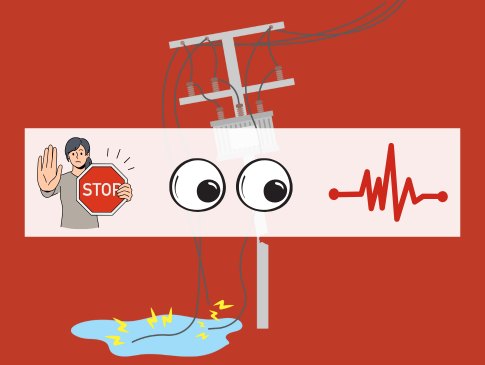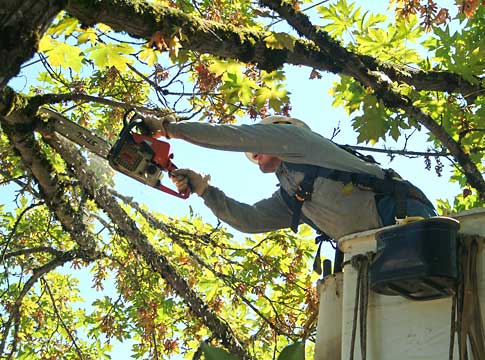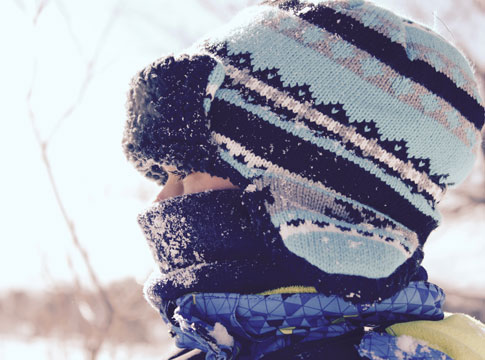Winter weather increases the likelihood of storm-related power outages. High winds, wet snowfall, and ice accumulation can cause trees and branches to fall on power lines. Preparing your home and family before the bad weather hits is important. Here are a few tips to help you prepare for a winter weather emergency.
"Be 2 Weeks Ready"
Experts recommend being two weeks ready for an emergency. This means having enough non-perishable food, water, and emergency supplies for your family to last two weeks in an emergency such as a prolonged power outage.
Water Storage
- Store 14 gallons of water per person (one gallon per person, per day is enough for two weeks).
Make a food plan
Choose foods your household will eat that don't require refrigeration and have a long shelf life. COST TIP: Add one can of food to your shopping cart each time you visit the store to help reduce expensive bulk purchases.
- Ready-to-eat canned meats, fish, fruits, and vegetables
- Protein bars and fruit bars
- Pudding cups
- Dried cereal and granola
- Comfort foods
- Canned soups and chilis
- Non-perishable pasteurized milk in cans or cartons
- Food for infants
- Pet food
SAFETY TIP: Do not eat refrigerated food if you've lost power for longer than four hours or if it has been exposed to temperatures higher than 40 degrees. Also, do not eat frozen food that has thawed.
Build an emergency first aid kit for your home AND vehicle.
Here are a few supplies to include that will help you during a power outage:
- Emergency blankets and sleeping bags
- Flashlights and extra batteries
- Battery-powered radio
- Battery-powered night lights
- Power banks to recharge phones and electronics
- Alternative cooking appliances that do not require electricity or gas
- Waste and hygiene disposal plan
- Back-up storage plan for refrigerated medications

Staying warm in a power outage
If there is an extended power outage in the middle of winter, you'll need to take steps to keep your home as warm and comfortable as possible.
- Avoid opening and closing exterior doors.
- Set up "camp" in one room, and close off the rest of the house.
- Close interior doors, and hang blankets across passage ways to help retain heat.
- Place rolled up towels at the base of exterior doors.
- Cover the windows with blankets and/or plastic.
- Put blankets, rugs or pillows on the floor to further insulate the room.
- Wear loose layers of clothes.
If you see a downed power line
STOP. There's no way to know if a downed line is energized, so play it safe—assume it is live. Stay at least 50 feet away (about the length of a school bus).
OBSERVE. Carefully observe the area. Downed lines can energize the ground and nearby objects, and electricity from the line can travel through water puddles. Stay at least 50 feet away from anything that could be energized, and instruct others to stay away.
SURVIVE. Call 911 to report a downed power line then call EWEB's outage reporting line at 1-844-484-2300 to report the downed line. NEVER approach or attempt to move a line under any circumstances.
If you see someone touching a power line, don't touch him or her; you may become a victim, too. Call 911 immediately.
If a power line falls across your car, try to drive clear. If that fails, stay in the car. If you must get out because of imminent danger, such as fire, be sure to leap clear so you don't touch the vehicle and the ground at the same time.
If you see repair crews working on downed power lines, please drive carefully. Expect delays and use caution when driving near any repair crews working to restore your power.


Trees and safety
When pruning or removing a tree, safety should be your main concern. Before you begin work on a tree, survey the area for overhead power lines. If you see lines in or near the tree you are planning to work on, please get in touch with us. Avoid working near power lines as contact can cause serious injury or death.
Important safety tips:
- Look up and live! Watch for overhead power lines when moving ladders or tools.
- Inspect your trees in the fall before winter weather arrives. And after a storm with wind, ice or snow survey your trees for damage. Give us a call if trees or branches near power lines appear hazardous or damaged.
- Do not let children play near power lines. Even if a tree isn't touching the lines, a child's weight on a branch could bring it in contact with a live line.
Preventing frozen pipes
Save yourself the hassle and cost of emergency repairs by locating pipes in areas that have a higher risk for freeze damage. Then take a few simple steps to reduce the risk of burst pipes.
- Wrap pipes located in unheated areas - such as an attic, crawl space or garage - with foam pipe insulation.
- Drain water from underground sprinkler piping and backflow prevention assembly. Wrap the assembly with foam insulation.
- Disconnect and drain garden hoses. If you don't have frost-proof outdoor faucets, install an insulated cover.
Locate your water meter:
- Make sure your customer-side hand valve shuts your water off completely.


